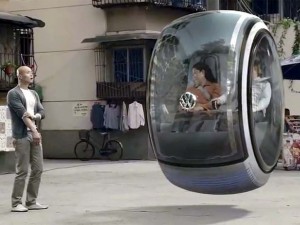It looks like a flying glass donut and would seem more appropriate in a remake of the Jetsons but Volkswagen’s hovercraft concept is a bit more than just sci-fi.
The prototype emerges from the “People’s Car Project,” a crowd-sourcing program VW has set up in China to encourage owners and fans to submit ideas about what sort of cars they’d like to drive in the future.
The disc-shaped hovercraft can seat two people and uses magnetic levitation to ride several inches over the road surface. That’s a bit different from a conventional hovercraft which rides on a cushion of air.
The underlying concept is, in fact, anything but science fiction. China already has a magnetic levitation train running between downtown Shanghai and the city’s main airport. There are plans under discussion to create a network of similar lines across the country.
The advantage is that the technology reduces friction and can be highly energy efficient. But it requires a magnetic grid to be placed over tracks or roadway. The hovercraft concept uses special sensors to remain properly positioned over that grid and to avoid other vehicles.
The hovercraft can move forward or back, left or right and even spin on the proverbial dime.
(Terrafugia ready to launch sales of its flying car. Click Here for that story.)
Meanwhile, the system can be programmed to operate autonomously, allowing a motorist to simply plug in a destination, set back and enjoy the ride.
That part of the concept appears to be far closer to reality. Nevada recently became the first step in the U.S. to create a license plate specifically for autonomous vehicles, Google acquiring the first plate. A number of manufacturers are now working on self-driving technologies and some experts believe such vehicles could be available in showrooms before decade’s end.
Magnetic levitation is also viable but establishing an infrastructure for such technology isn’t considered likely in the near-term, if ever.
The Volkswagen Hover Car itself produces no emissions – though, as with any other electric vehicle in China the system draws energy from the country’s heavily polluting coal-fired electric infrastructure.
“We are no longer just building cars for, but also with customers and at the same time initiating a national dialog which gives us a deep insight into the design preferences, needs and requirements of Chinese customers,” said VW’s marketing chief Luca de Meo during the recent unveiling of the hovercraft.
VW says it has so far received 119,000 different ideas through the People’s Car Project – appropriately named as Volkswagen translates, in German, into “people’s car.” The maker decided to build prototypes of the three most intriguing ideas it received.

